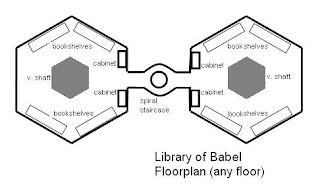[Update: Jamie Zawinsky has great post on this theme in which he rejects my proposal that assumes that Borges knew what he was doing and had a clear image in mind. I think he meant us to suspect that the librarian is deranged, of course. HT, Carey Dunne.]
[Update 2: It's good to know one is not alone. Jonathan Basile has been puzzled too.]
Any ass can assimilate the main points of Tolstoy's attitude toward adultery but in order to enjoy Tolstoy's art the good reader must wish to visualize, for instance, the arrangement of a railway carriage on the Moscow-Petersburg night train as it was a hundred years ago. Here diagrams are most helpful.Vladimir Nabokov
Interview in Vogue, 1969
To clarify the ideas in my previous post, I have produced the following floor plan.

I have decided to render Borges's "gabinetes" as "cabinets", not "closets", i.e., as fixtures rather than rooms, and I have installed bookshelves as furniture. Both may of course be more "built in" without changing the main point. Keep in mind that this is one of very, very many floors in what therefore comes to look like a tower. I lean to the interpretation that it would not be infinitely tall, but I sometimes indulge in the "elegant hope" that it is a giant ring suspended in space, so that if you ascend the staircase long enough, you arrive back where you started. The gravity of this situation, as it were, would be a mystery.
I have no idea where the Librarian gets the idea that the Library might be "a sphere whose exact centre is any one of its hexagons and whose circumference is inaccessible." Then again, I am also not convinced that the principle that determines the contents of the library is fully known, i.e., I am not sure that "the Library is total". I believe these two issues help us to refute the Librarian's speculative "dream that [the mirror in the hallway] represents and promises the infinite."
No comments:
Post a Comment